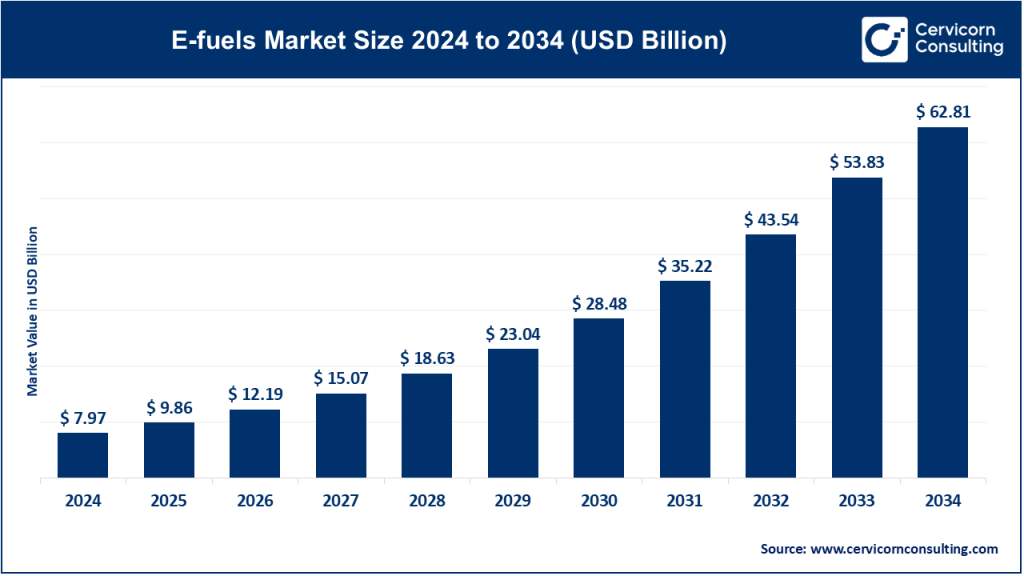E-fuels Market Overview
What is the E-Fuels Market?
The E-fuels market focuses on synthetic fuels produced through renewable energy sources, water, and carbon dioxide. Known as electrofuels, these fuels are a sustainable alternative to fossil fuels. The production process often involves hydrogen generated by electrolysis, combined with captured CO2 to create hydrocarbons. These fuels can power internal combustion engines and are compatible with existing fuel infrastructure, making them a viable solution for reducing greenhouse gas emissions.
Why is the E-Fuels Market Important?
Carbon Neutrality: E-fuels are produced through a sustainable process where CO₂ is captured either directly from the atmosphere or from industrial emissions and combined with green hydrogen derived from renewable energy sources like wind and solar power. This closed-loop production cycle ensures that the carbon released during e-fuel combustion is offset by the carbon captured during its production, resulting in minimal net emissions. This feature aligns e-fuels with global carbon neutrality targets and makes them an essential part of the broader decarbonization strategy.
Energy Security: The reliance on fossil fuels poses significant risks to energy security due to price volatility and geopolitical tensions. E-fuels offer an alternative by utilizing renewable energy, diversifying the energy mix, and reducing dependence on imports of oil and natural gas. By strengthening domestic energy production capabilities, e-fuels provide stability and independence, ensuring that energy supply is less susceptible to external shocks.
Infrastructure Compatibility: A key advantage of e-fuels is their ability to integrate seamlessly into existing energy systems. E-fuels can be used in current internal combustion engines, storage facilities, and distribution networks without the need for substantial modifications. This compatibility reduces the financial and logistical barriers often associated with transitioning to new energy technologies, enabling a smoother and more cost-effective adoption process.
Decarbonization of Hard-to-Electrify Sectors: Certain sectors, such as aviation, maritime shipping, and heavy-duty transportation, have high energy demands that cannot be met efficiently through direct electrification. E-fuels serve as a viable alternative, offering the energy density and performance required by these industries while significantly lowering emissions. By addressing the unique challenges of these sectors, e-fuels contribute to a more comprehensive decarbonization of the global economy.
Climate Change Mitigation: The production and use of e-fuels align with efforts to combat climate change by providing a sustainable energy source that leverages renewable energy and CO₂ capture technologies. They help maintain energy reliability while significantly reducing greenhouse gas emissions, making them a crucial component of global strategies to limit temperature rise and meet international climate agreements such as the Paris Accord.
Get a Free Sample: https://www.cervicornconsulting.com/sample/2467
Key Players in the E-Fuels Market
Below is an overview of the top companies in the E-fuels market, highlighting their specializations, key focus areas, notable features, approximate 2023 revenue, market share, and global presence:
Archer Daniels Midland Co. (ADM)
- Specialization: Bio-based fuel production, including ethanol and biodiesel.
- Key Focus Areas: Advancing renewable fuel technology.
- Notable Features: Large-scale production facilities; integration with agricultural supply chains.
- 2023 Revenue: Approx. $102 billion.
- Market Share: ~15%.
- Global Presence: Strong footprint in North America, Europe, and South America.
Ballard Power Systems, Inc.
- Specialization: Hydrogen fuel cells and related technologies.
- Key Focus Areas: Fuel cell solutions for transportation and stationary power.
- Notable Features: Proven expertise in hydrogen infrastructure.
- 2023 Revenue: Approx. $120 million.
- Market Share: ~5%.
- Global Presence: Active in North America, Europe, and Asia-Pacific.
Ceres Power Holding Plc
- Specialization: Solid oxide fuel cells (SOFC).
- Key Focus Areas: Decentralized power generation and hydrogen production.
- Notable Features: Advanced fuel cell technology with high efficiency.
- 2023 Revenue: Approx. $75 million.
- Market Share: ~3%.
- Global Presence: Europe, North America, and Asia-Pacific.
Clean Fuels Alliance America
- Specialization: Advocacy and development of biodiesel and renewable diesel.
- Key Focus Areas: Policy advocacy and market development.
- Notable Features: Significant influence on U.S. renewable fuel policies.
- 2023 Revenue: N/A (non-profit).
- Market Share: N/A.
- Global Presence: Primarily North America.
Climeworks AG
- Specialization: Direct air capture (DAC) technology.
- Key Focus Areas: CO2 capture for synthetic fuel production.
- Notable Features: Scalable DAC plants.
- 2023 Revenue: Approx. $20 million.
- Market Share: ~1%.
- Global Presence: Europe and select projects globally.

